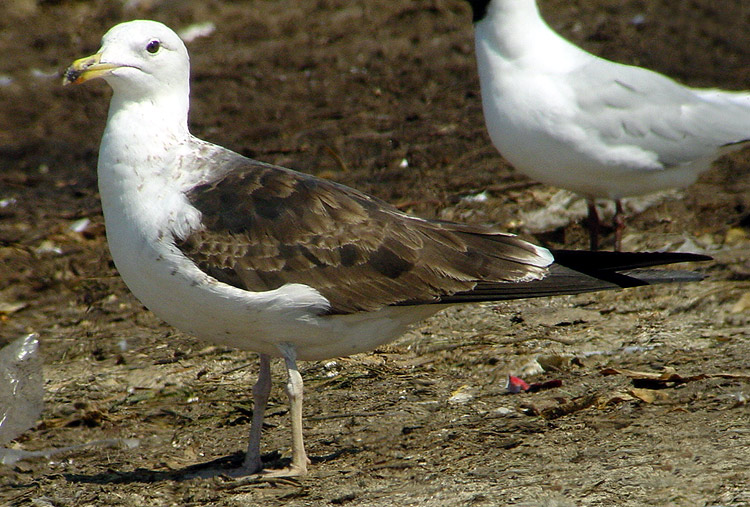(2 images) Larus fuscus fuscus 2cy, July 09-17 2003, Tampere, Finland (61.33N 24.59E).

Two other examples of the most obvious and 'abundant' type of 2cy fuscus in Finland in July, although many 2cy birds do not make the journey all the way back to Scandinavia. Numbers of 2cy birds in July on best days still don't exceed 50, with just a handful of ringed birds. This type of 2cy could easily be mistaken for 3cy intermedius / graellsii birds in W Europe. Note the worn pale brown second generation wing-coverts and scapulars, mixed with new blackish brown third generation feathers. All primaries, P1-P10 were replaced for second generation flight feathers on the wintering ground and are still present. The tail-feathers and all secondaries are second generation as well.
Many scapulars are third generation already, rather dark blackish brown, lacking any obvious barring or patterns, except the dark shaft-streak. In both birds, several median coverts and some lower lesser coverts have been replaced recently, probably third generation feathers and they obviously stand out in the otherwise paler brown wing-covert panel.
The bare parts coloration would easily apply to 3cy intermedius, with the bill largely yellow and the dark iris. Note the moult in head feathers in the bottom image.
These are examples of typical Finnish fuscus, representing average 2cy fuscus in completely replaced primaries, rectrices and secondaries on the wintering grounds, prior to northbound migration. The new second generation primaries are only a couple of months old and still look dark blackish. The second generation tail-feathers normally still show the white tips, but in some individuals these tips are worn away when 2cy birds arrive back in Scandinavia. Immediately after returning in Scandinavia some 2cy fuscus start a new moult cycle in the inner primaries, now growing in third generation feathers.
The complete moult in the winter quarters normally start with replacement of the scapulars and mantle-feathers. The new scapulars often show a simple pattern of a black shaft-streak on a dark brown base. The post-juvenile moult may already start in juvenile birds which are still in Scandinavia in September. When most of the scapulars are replaced, fuscus start to replace the wing-coverts, in the ordinary sequence that can also be found in other gull taxa in Europe. Wing-covert moult is initiated in two loci, one wave starts in the outermost coverts, one wave starts in the innermost coverts. The two waves normally meet at covert #7-8. Normally the median covert row is the first row which is moulted, followed by the lower lesser coverts, the greater coverts and moult finishes in the outer lesser coverts (the carpal edge). If for whatever reason, moult in the wing-coverts is arrested, this is normally most obvious in the carpal edge, containing juvenile feathers which contrast with the other fresh coverts.
In classical 2cy fuscus, all wing-coverts are replaced to second generation on the wintering grounds, and by mid July, a next moult wave is initiated, often including the median and lower lesser coverts, the inner greater coverts, upper tertials and scapulars. Bare part coloration may be very immature, including a black bill, but may also be very mature, with a yellow base and a red gonydeal spot on the lower mandible. Still, these birds are only 12 months old.

|
 nominate Lesser Black-backed Gull (L. fuscus)
nominate Lesser Black-backed Gull (L. fuscus)
